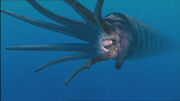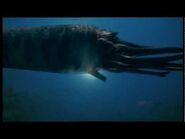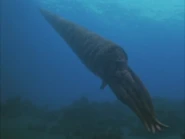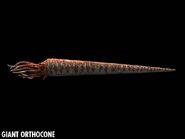| “ | And there it is! It's an orthocone! | ” |
The Orthocone (also known as Cameroceras in The Complete Guide to Prehistoric Life) is a big invertebrate from the Ordovician. It was the largest animal to have ever existed during that time.
Creature attributes[]
Physical appearance and biology[]
The Orthocone is a large mollusk that belonged to the nautiloids, such as the modern Nautilus. It had several tentacles, which, unlike the tentacles of modern cephalopods like the cuttlefish and the squid, didn't range in size, but were of a generally similar length. Also, these tentacles didn't have suction cups, but rather the tentacles were ridged on their inner side.
In the center of its face was a large, sharp, parrot-like beak that was used to crush through carapaces of such arthropods like Megalograptus.
It had large, primitive eyes which were sensitive to contact with bright lights.
At the bottom of the animal was a tube-shaped device called a hyponome. This was used to propel the animal through the water.
The Orthocone has a long, cone-shaped shell which was covered in stripes. The shell was largely hollow, the mollusk occupied only its front end, and the rest of it consisted of gas-filled chambers that could be flooded with water, which could be expelled lately. In this manner Cameroceras adjusted its buoyancy and weight as it rose to the surface or sank - this creature wasn't very manouverable.
Behaviour and traits[]
The Orthocone was an alpha predator of the Ordovician, as it was the largest animal. Most of its size consisted of its long, narrow shell. The size ratio between the shell and the animal itself was very large - the shell could amount up to 90% of the animal's entire length.
The Orthocone lived in dimly-lit parts of the sea as its eyes were very primitive and were sensitive to light. In any instance where bright light came in contact with its eyes, the mollusk would try to escape it.
The primary weapon of the Orthocone was its beak. Once it caught its prey, it would drag the animal towards its beak with its tentacles. The beak would then crack apart the carapace and would then proceed in feeding on the softer innards.
In Sea Monsters[]
Dangerous Seas[]
In the Ordovician, Nigel Marven saw that a large, tentacled creature was eating the Trilobite cam. As he tried to reel in the camera, he noticed that the animal was extremely heavy. He then quickly suited up in his diving gear and dove into the water to follow it.

As he found a group of Megalograptus gathering, Nigel noticed the creature - an Orthocone above him. As the mollusk approached him, he flashed his torch in its eyes and shunned it away.
Just as he thought that the Orthocone had gone, it reappeared and attacked a Megalograptus. It pushed the prey into its beak and killed it. It then proceeded in killing another sea scorpion.
Nigel followed the Orthocone and held onto its shell and hitched a ride. Nigel then noticed that the orthocone was swimming deeper into the water and let go.
In Walking with Monsters[]
Water Dwellers[]
A pair of unidentified Orthocones (which use the same model as Cameroceras) were swimming in the Silurian seas alongside Pterygotus and other marine invertebrates of that time.
Gallery[]
Behind the Scenes[]
In Walking with Monsters, the Orthocone reuses the Orthocone model used in Sea Monsters (or vice versa). However, it is a different (and unidentified) genus that lived during the Silurian period instead of the Ordivician period. In the Russian version of Walking with Monsters, it is erroneously identified as Orthoceras.
List of appearance[]
- Sea Monsters
- Dangerous Seas
- Into the Jaws of Death (opening credits and time map only)
- To Hell... and Back? (opening credits and time map only)
- Sea Monsters: Prehistoric Predators of the Deep
- Sea Monsters Adventure Game
- Walking with Monsters
- Water Dwellers (cameo, identified as Orthoceras in Russian version)
- The Complete Guide to Prehistoric Life
Notes and references[]
|




